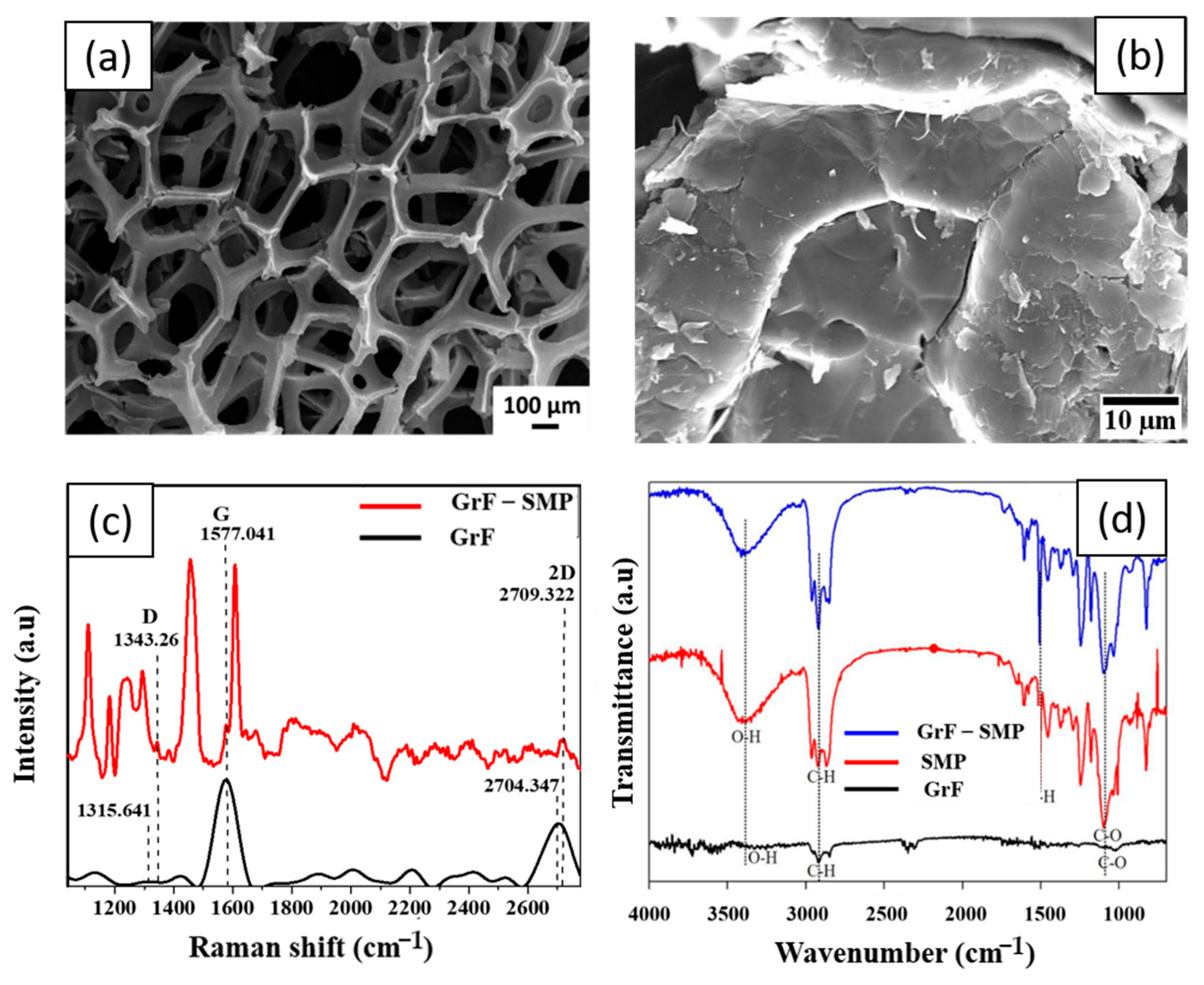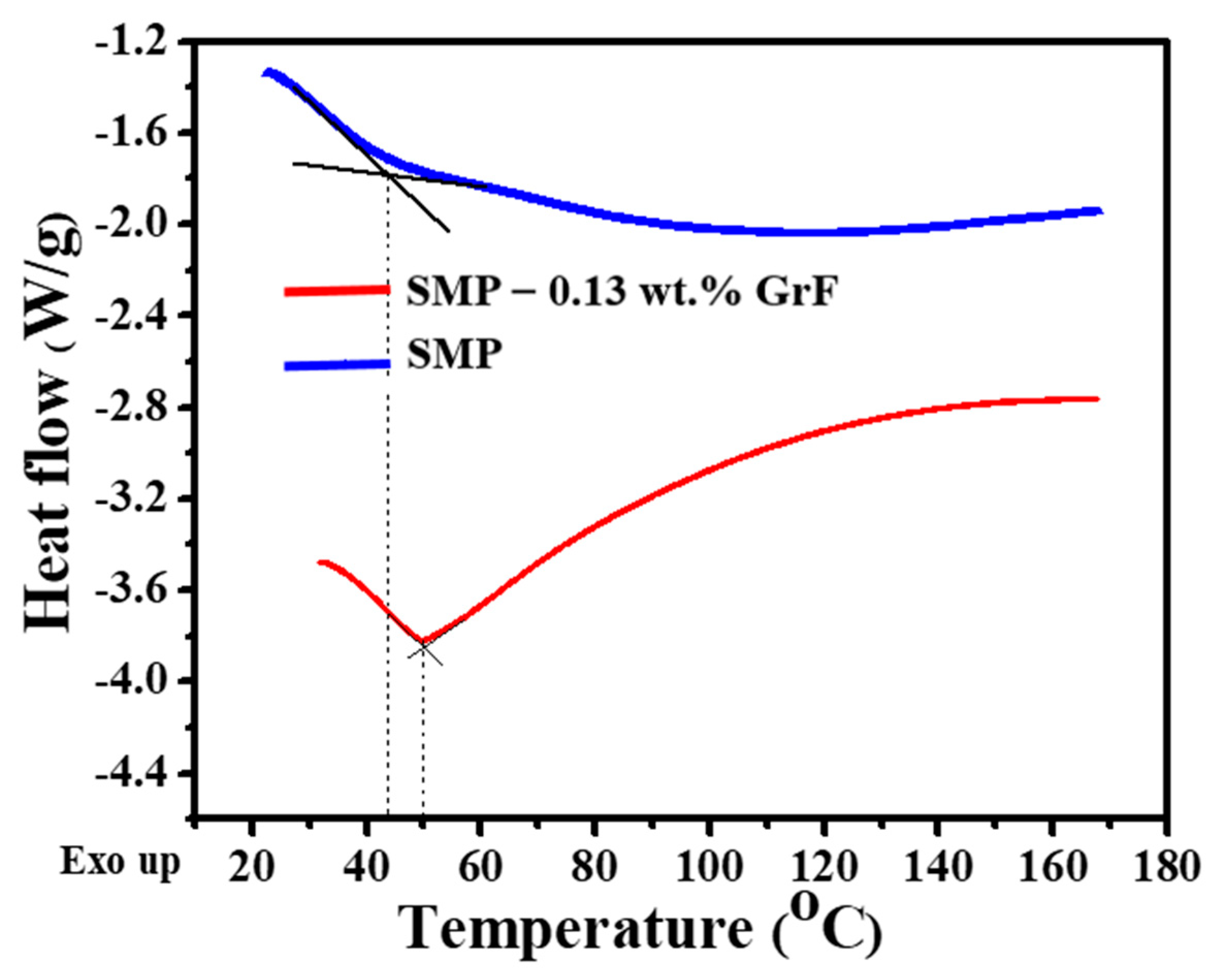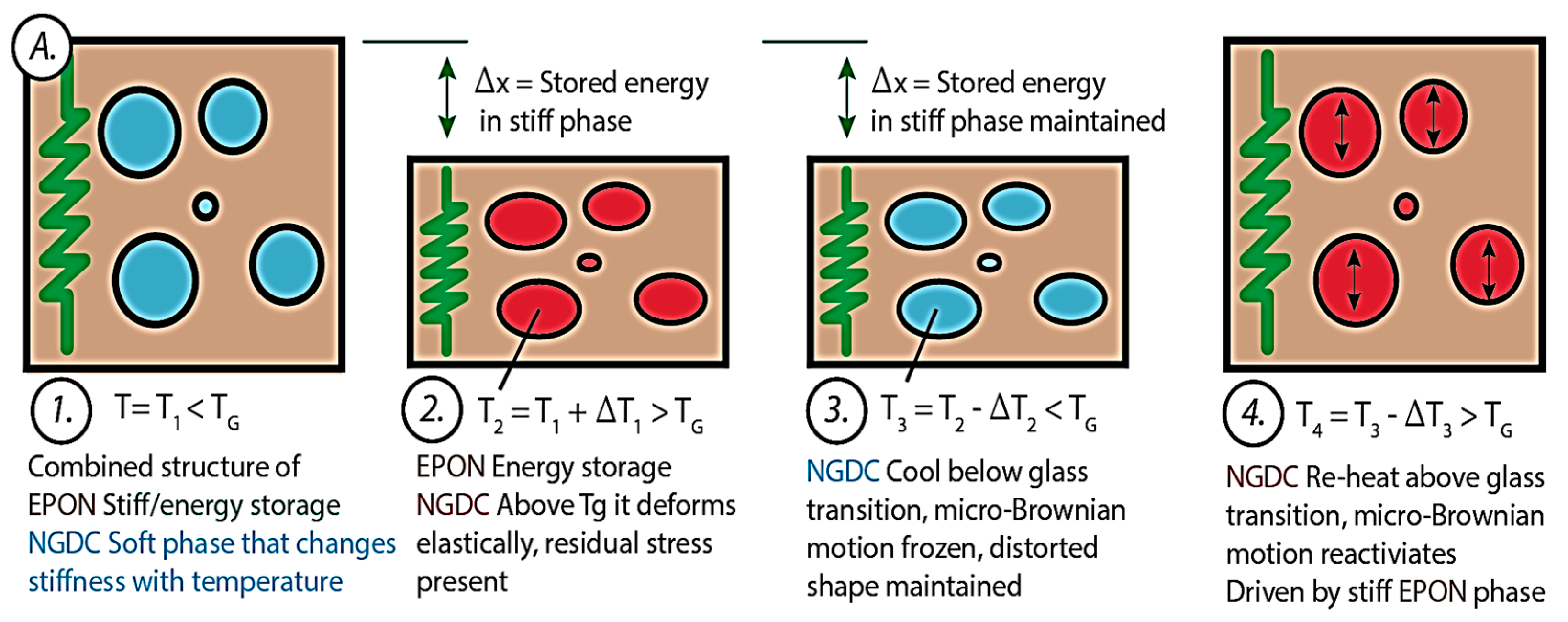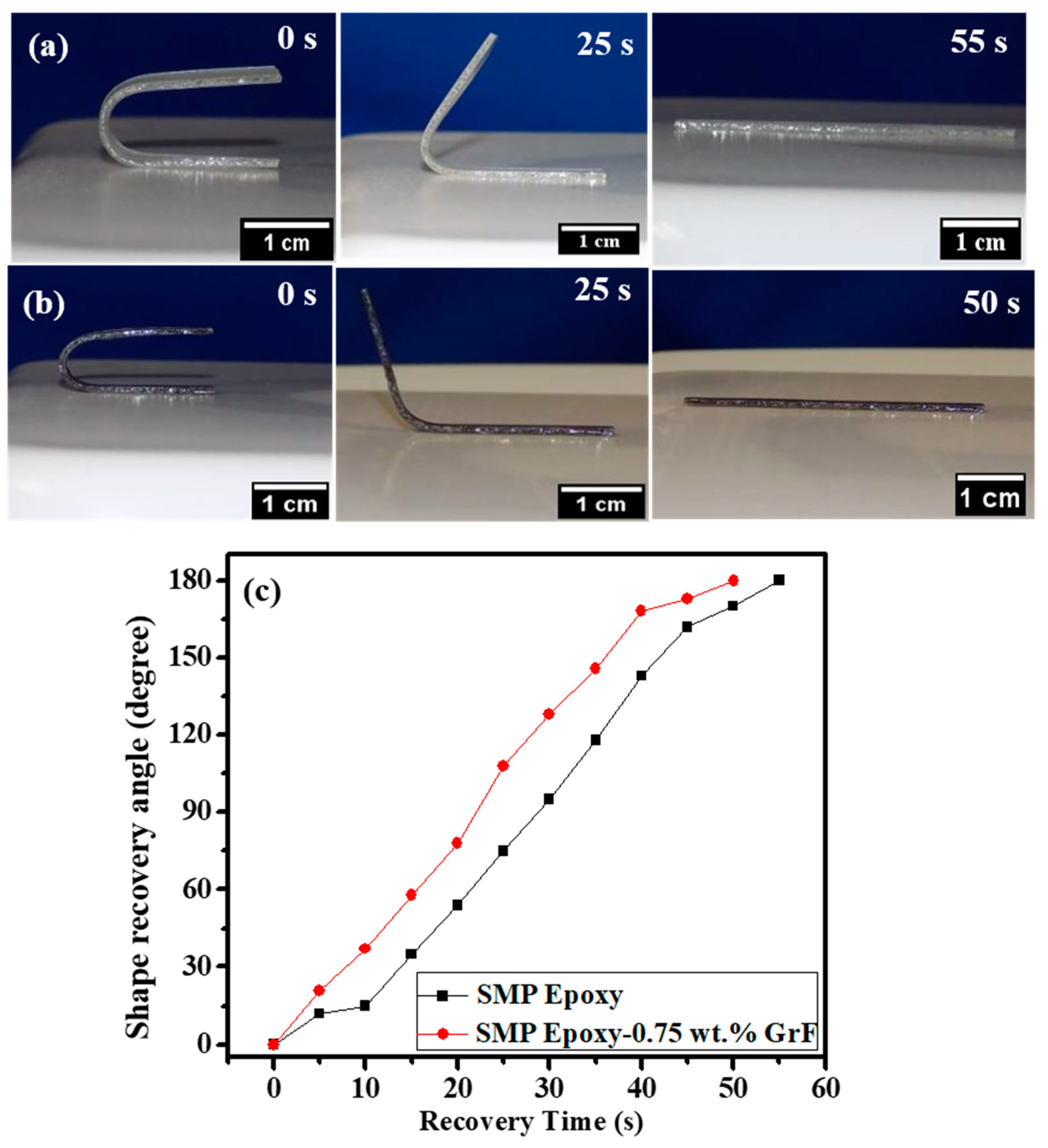Electrically and Thermally Triggered Three-Dimensional Graphene-Foam-Reinforced Shape Memory Epoxy Composites
Abstract
:1. Introduction
2. Materials and Methods
2.1. Materials
2.2. Fabrication of GrF-Epoxy SMP Composite by Mold Casting
2.3. Microstructure and Phase Characterization
2.4. Thermal Properties’ Characterization
2.5. Shape Memory Recovery Measurements
3. Results and Discussion
3.1. Microstructure of GrF-Shape Memory Epoxy Composite
3.2. Glass Transition of GrF-Epoxy SMP Composites
3.3. Thermal Actuation of GrF-Epoxy SMP Composites
3.3.1. Temporal Gradient Behavior of SMP Epoxy-GrF Composite
3.3.2. Effect of Switching Temperatures on the Shape Recovery Rate
3.3.3. Influence of Thermo-Mechanical (T-M) Cycles on the Glass Transition Temperature
3.4. Electrical Actuation of Epoxy SMP and GrF-Epoxy SMP Composite
3.5. Self-Healing Effect in Bird’s Wing Made of GrF-Epoxy SMP Composite
4. Conclusions
5. Patents
Supplementary Materials
Author Contributions
Funding
Institutional Review Board Statement
Data Availability Statement
Acknowledgments
Conflicts of Interest
References
- Gall, K.; Yakacki, C.M.; Liu, Y.; Shandas, R.; Willett, N.; Anseth, K.S. Thermomechanics of the shape memory effect in polymers for biomedical applications. J. Biomed. Mater. Res.-Part A 2005, 73, 339–348. [Google Scholar] [CrossRef] [PubMed]
- Zarek, M.; Layani, M.; Cooperstein, I.; Sachyani, E.; Cohn, D.; Magdassi, S. 3D Printing of Shape Memory Polymers for Flexible Electronic Devices. Adv. Mater. 2016, 28, 4449–4454. [Google Scholar] [CrossRef] [PubMed]
- Leng, J.; Lan, X.; Liu, Y.; Du, S. Shape-memory polymers and their composites: Stimulus methods and applications. Prog. Mater. Sci. 2011, 56, 1077–1135. [Google Scholar] [CrossRef]
- Zhao, Q.; Qi, H.J.; Xie, T. Recent progress in shape memory polymer: New behavior, enabling materials, and mechanistic understanding. Prog. Polym. Sci. 2015, 49–50, 79–120. [Google Scholar] [CrossRef] [Green Version]
- Brostowitz, N.R.; Weiss, R.A.; Cavicchi, K.A. Facile Fabrication of a Shape Memory Polymer by Swelling Cross-Linked Natural Rubber with Stearic Acid. ACS Macro Lett. 2014, 24, 374–377. [Google Scholar] [CrossRef]
- Huang, W.M.; Ding, Z.; Wang, C.C.; Wei, J.; Zhao, Y.; Purnawali, H. Shape-memory materials. Mater. Today 2010, 13, 54–61. [Google Scholar] [CrossRef]
- Rousseau, I.A. Challenges of Shape Memory Polymers: A Review of the Progress toward Overcoming SMP’s Limitations. Polym. Eng. Sci. 2008, 48, 2075–2089. [Google Scholar] [CrossRef]
- Lendlein, A.; Kelch, S. Shape-Memory Effect from permanent shape. Angew. Chem. 2002, 41, 2034–2057. [Google Scholar] [CrossRef]
- Cho, J.W.; Kim, J.W.; Jung, Y.C.; Goo, N.S. Electroactive shape-memory polyurethane composites incorporating carbon nanotubes. Macromol. Rapid Commun. 2005, 26, 412–416. [Google Scholar] [CrossRef]
- Lendlein, A.; Jiang, H.; Jünger, O.; Langer, R. Light-induced shape-memory polymers. Nature 2005, 434, 879–882. [Google Scholar] [CrossRef]
- Schmidt, A.M. Electromagnetic activation of shape memory polymer networks containing magnetic nanoparticles. Macromol. Rapid Commun. 2006, 27, 1168–1172. [Google Scholar] [CrossRef]
- Bai, T.; Han, Y.; Zhang, P.; Wang, W.; Liu, W. Zinc ion-triggered two-way macro-/microscopic shape-changing and memory effects in high strength hydrogels with pre-programmed unilateral patterned surfaces. Soft Matter 2012, 8, 6846. [Google Scholar] [CrossRef]
- Li, G.; Fei, G.; Xia, H.; Han, J.; Zhao, Y. Spatial and temporal control of shape memory polymers and simultaneous drug release using high intensity focused ultrasound. J. Mater. Chem. 2012, 22, 7692. [Google Scholar] [CrossRef]
- Idowu, A.; Thomas, T.; Boesl, B.; Agarwal, A. Cryo-Assisted Extrusion Three-Dimensional Printing of Shape Memory Polymer–Graphene Composites. J. Manuf. Sci. Eng. 2023, 145, 041003. [Google Scholar]
- Avila, J.M.; Cavender-Word, T.J.; Roberson, D.A. Exploring the effect of moisture exposure on shape memory polymer performance. J. Polym. Environ. 2023, 1–12. [Google Scholar] [CrossRef]
- Pilate, F.; Mincheva, R.; De Winter, J.; Gerbaux, P.; Wu, L.; Todd, R.; Dubois, P. Design of multi stimuli-responsive shape-memory polymer materials by reactive extrusion. Chem. Mater. 2014, 26, 5860–5867. [Google Scholar] [CrossRef]
- Garces, I.T.; Ayranci, C. Advances in additive manufacturing of shape memory polymer composites. Rapid Prototyp. J. 2021, 27, 379–398. [Google Scholar] [CrossRef]
- Rahmatabadi, D.; Aberoumand, M.; Soltanmohammadi, K.; Soleyman, E.; Ghasemi, I.; Baniassadi, M.; Baghani, M. A New Strategy for Achieving Shape Memory Effects in 4D Printed Two-Layer Composite Structures. Polymers 2022, 14, 5446. [Google Scholar] [CrossRef]
- Rahmatabadi, D.; Ghasemi, I.; Baniassadi, M.; Abrinia, K.; Baghani, M. 4D printing of PLA-TPU blends: Effect of PLA concentration, loading mode, and programming temperature on the shape memory effect. J. Mater. Sci. 2023, 58, 7227–7243. [Google Scholar] [CrossRef]
- Rimdusit, S.; Lohwerathama, M.; Hemvichian, K.; Kasemsiri, P.; Dueramae, I. Shape memory polymers from ben-oxazine-modified epoxy. Smart Mater. Struct. 2013, 22, 075033. [Google Scholar] [CrossRef]
- Zheng, N.; Fang, G.; Cao, Z.; Zhao, Q.; Xie, T. High strain epoxy shape memory polymer. Polym. Chem. 2015, 6, 3046–3053. [Google Scholar] [CrossRef]
- Wu, X.; Liu, Y.; Leng, J. Investigation of mechanical behavior of epoxy shape memory polymers. Proc. SPIE 2009, 7289, 72890Z. [Google Scholar]
- Chen, W.; Fan, P. Epoxy shape memory polymer (SMP): Material preparation, uniaxial tensile tests, and dynamic mechanical analysis. Polym. Test. 2017, 62, 335–341. [Google Scholar] [CrossRef]
- Liu, C.; Mather, P.T. A shape memory polymer with improved shape recovery. Mater. Res. Soc. Symp. Proc. 2005, 855, 1–6. [Google Scholar] [CrossRef] [Green Version]
- Cao, F.; Jana, S.C. Nanoclay-tethered shape memory polyurethane nanocomposites. Polymer 2007, 48, 3790–3800. [Google Scholar] [CrossRef]
- Gall, K.; Mikulas, M.; Munshi, N.A.; Beavers, F.; Tupper, M. Carbon fiber reinforced shape memory polymer composites. J. Intell. Mater. Syst. Struct. 2000, 11, 877–886. [Google Scholar] [CrossRef]
- Chen, L.; Chen, W.; Li, B.; Yang, Q. Investigation of shape memory and heat transfer properties of graphene oxide (GO) reinforced shape memory epoxy resin composites. Mater. Today Commun. 2023, 34, 105170. [Google Scholar] [CrossRef]
- D’Elia, E.; Ahmed, H.S.; Feilden, E.; Saiz, E. Electrically-responsive graphene-based shape-memory composites. Appl. Mater. Today 2019, 15, 185–191. [Google Scholar] [CrossRef]
- Wang, E.; Dong, Y.; Islam, M.Z.; Yu, L.; Liu, F.; Chen, S.; Qi, X.; Zhu, Y.; Fu, Y.; Xu, Z.; et al. Effect of graphene oxide-carbon nano-tube hybrid filler on the mechanical property and thermal response speed of shape memory epoxy composites. Compos. Sci. Technol. 2019, 169, 209–216. [Google Scholar] [CrossRef]
- Soldano, C.; Mahmood, A.; Dujardin, E. Production, properties and potential of graphene. Carbon 2010, 48, 2127–2150. [Google Scholar] [CrossRef] [Green Version]
- Graphene, S.; Balandin, A.A.; Ghosh, S.; Bao, W.; Calizo, I. Superior Thermal Conductivity. Nano Lett. 2008, 8, 902–907. [Google Scholar]
- Frank, I.W.; Tanenbaum, D.M.; van der Zande, A.M.; McEuen, P.L. Mechanical properties of suspended graphene sheets. J. Vac. Sci. Technol. B Microelectron. Nanom. Struct. 2007, 25, 2558. [Google Scholar] [CrossRef] [Green Version]
- Gong, L.; Kinloch, I.A.; Young, R.J.; Riaz, I.; Jalil, R.; Novoselov, K.S. Interfacial stress transfer in a graphene monolayer nanocomposite. Adv. Mater. 2010, 22, 2694–2697. [Google Scholar] [CrossRef] [Green Version]
- Yoonessi, M.; Shi, Y.; Scheiman, D.A.; Lebron-Colon, M.; Tigelaar, D.M.; Weiss, R.A.; Meador, M.A. Graphene polyimide nanocomposites; Thermal, mechanical, and high-temperature shape memory effects. ACS Nano 2012, 6, 7644–7655. [Google Scholar] [CrossRef]
- Wang, W.; Liu, D.; Liu, Y.; Leng, J.; Bhattacharyya, D. Electrical actuation properties of reduced graphene oxide paper/epoxy-based shape memory composites. Compos. Sci. Technol. 2015, 106, 20–24. [Google Scholar] [CrossRef]
- Lu, H.; Gou, J. Study on 3-D High Conductive Graphene Buckypaper for Electrical Actuation of Shape Memory Polymer. Nanosci. Nanotechnol. Lett. 2012, 4, 1155–1159. [Google Scholar] [CrossRef]
- Wang, Y.; Tian, W.; Xie, J.; Liu, Y. Thermoelectric responsive shape memory graphene/hydro-epoxy composites for actuators. Micromachines 2016, 7, 145. [Google Scholar] [CrossRef] [Green Version]
- Williams, T.; Meador, M.; Miller, S.; Scheiman, D. Effect of Graphene Addition on Shape Memory Behavior of Epoxy Resins. In Proceedings of the Society of Advanced Materials Processing and Engineering, Cleveland, OH, USA, 17 October 2011; pp. 1–9. [Google Scholar]
- Jia, J.; Sun, X.; Lin, X.; Shen, X.; Mai, Y.-W.; Kim, J.-K. Exceptional electrical conductivity and fracture resistance of 3D interconnected graphene foam/epoxy composites. ACS Nano 2014, 8, 5774–5783. [Google Scholar] [CrossRef]
- Tang, L.-C.; Wan, Y.-J.; Yan, D.; Pei, Y.-B.; Zhao, L.; Li, Y.-B.; Wu, L.-B.; Jiang, J.-X.; Lai, G.-Q. The effect of graphene dispersion on the mechanical properties of graphene/epoxy composites. Carbon 2013, 60, 16–27. [Google Scholar] [CrossRef]
- Yavari, F.; Chen, Z.; Thomas, A.V.; Ren, W.; Cheng, H.-M.; Koratkar, N. High Sensitivity Gas Detection Using a Macroscopic Three-Dimensional Graphene Foam Network. Sci. Rep. 2011, 1, 166. [Google Scholar] [CrossRef] [Green Version]
- Nieto, A.; Boesl, B.; Agarwal, A. Multi-scale intrinsic deformation mechanisms of 3D graphene foam. Carbon 2015, 85, 299–308. [Google Scholar] [CrossRef]
- Pettes, M.T.; Ji, H.; Shi, L. Thermal Transport in Three-Dimensional Foam Architectures of Few-Layer Graphene and Ultrathin Graphite. Nano Lett. 2012, 12, 2959–2964. [Google Scholar] [CrossRef] [PubMed]
- Chen, G.; Liu, Y.; Liu, F.; Zhang, X. Fabrication of three-dimensional graphene foam with high electrical conductivity and large adsorption capability. Appl. Surf. Sci. 2014, 311, 808–815. [Google Scholar] [CrossRef]
- Shivakumar, R.; Leong, F.N.; Tsang, S.H.; Teo, E.H.T. Effect of loading fraction of three-dimensional graphene foam (3D-C) on thermal, mechanical, and shape memory properties of 3D-C/SMP composite. Mater. Res. Bull. 2021, 142, 111378. [Google Scholar] [CrossRef]
- Rong, J.; Zhou, J.; Zhou, Y.; Hu, C.; Li, L.; Guo, W. 3D Single-Layer-Dominated Graphene Foam for High-Resolution Strain Sensing and Self-Monitoring Shape Memory Composite. Small 2022, 18, 2205301. [Google Scholar] [CrossRef]
- Xie, T.; Rousseau, I.A. Facile tailoring of thermal transition temperatures of epoxy shape memory polymers. Polymer 2009, 50, 1852–1856. [Google Scholar] [CrossRef]
- Embrey, L.; Nautiyal, P.; Loganathan, A.; Idowu, A.; Boesl, B.; Agarwal, A. Three-Dimensional Graphene Foam Induces Multifunctionality in Epoxy Nanocomposites by Simultaneous Improvement in Mechanical, Thermal, and Electrical Properties. ACS Appl. Mater. Interfaces 2017, 9, 39717–39727. [Google Scholar] [CrossRef]
- Nautiyal, P.; Boesl, B.; Agarwal, A. Harnessing Three Dimensional Anatomy of Graphene Foam to Induce Superior Damping in Hierarchical Polyimide Nanostructures. Small 2016, 13, 1603473. [Google Scholar] [CrossRef]
- Ferrari, A.C.; Meyer, J.C.; Scardaci, V.; Casiraghi, C.; Lazzeri, M.; Mauri, F.; Piscanec, S.; Jiang, D.; Novoselov, K.S.; Roth, S.; et al. Raman spectrum of graphene and graphene layers. Phys. Rev. Lett. 2006, 97, 187401. [Google Scholar] [CrossRef] [Green Version]
- Chae, S.J.; Güneş, F.; Kim, K.K.; Kim, E.S.; Han, G.H.; Kim, S.M.; Shin, H.J.; Yoon, S.M.; Choi, J.Y.; Park, M.H.; et al. Synthesis of large-area graphene layers on poly-nickel substrate by chemical vapor deposition: Wrinkle formation. Adv. Mater. 2009, 21, 2328–2333. [Google Scholar] [CrossRef]
- Liu, Y.; Sun, H.; Tan, H.; Du, X. Modified shape memory epoxy resin composites by blending activity polyurethane. J. Appl. Polym. Sci. 2013, 127, 3152–3158. [Google Scholar] [CrossRef]
- Jin, Z.; McNicholas, T.P.; Shih, C.-J.; Wang, Q.H.; Paulus, G.L.C.; Hilmer, A.J.; Shimizu, S.; Strano, M.S. Click chemistry on solution-dispersed graphene and monolayer CVD graphene. Chem. Mater. 2011, 23, 3362–3370. [Google Scholar] [CrossRef]
- Emsley, B.J.; Bonds, S.H. Very Strong Hydrogen Bonding. Chem. Soc. Rev. 1980, 9, 91–124. [Google Scholar] [CrossRef]
- Zhang, P.; Yuan, P.; Jiang, X.; Zhai, S.; Zeng, J.; Xian, Y.; Qin, H.; Yang, D. A Theoretical Review on Interfacial Thermal Transport at the Nanoscale. Small 2017, 14, 1702769. [Google Scholar] [CrossRef]
- Liu, Y.; Du, H.; Liu, L.; Leng, J. Shape memory polymers and their composites in aerospace applications: A review. Smart Mater. Struct. 2014, 23, 023001. [Google Scholar] [CrossRef]
- Bustillos, J.; Zhang, C.; Boesl, B.; Agarwal, A. Three-dimensional graphene foam polymer composite with superior deicing efficiency and strength. ACS Appl. Mater. Interfaces 2018, 10, 5022–5029. [Google Scholar] [CrossRef]











Disclaimer/Publisher’s Note: The statements, opinions and data contained in all publications are solely those of the individual author(s) and contributor(s) and not of MDPI and/or the editor(s). MDPI and/or the editor(s) disclaim responsibility for any injury to people or property resulting from any ideas, methods, instructions or products referred to in the content. |
© 2023 by the authors. Licensee MDPI, Basel, Switzerland. This article is an open access article distributed under the terms and conditions of the Creative Commons Attribution (CC BY) license (https://creativecommons.org/licenses/by/4.0/).
Share and Cite
Idowu, A.; Thomas, T.; Bustillos, J.; Boesl, B.; Agarwal, A. Electrically and Thermally Triggered Three-Dimensional Graphene-Foam-Reinforced Shape Memory Epoxy Composites. Polymers 2023, 15, 2903. https://doi.org/10.3390/polym15132903
Idowu A, Thomas T, Bustillos J, Boesl B, Agarwal A. Electrically and Thermally Triggered Three-Dimensional Graphene-Foam-Reinforced Shape Memory Epoxy Composites. Polymers. 2023; 15(13):2903. https://doi.org/10.3390/polym15132903
Chicago/Turabian StyleIdowu, Adeyinka, Tony Thomas, Jenniffer Bustillos, Benjamin Boesl, and Arvind Agarwal. 2023. "Electrically and Thermally Triggered Three-Dimensional Graphene-Foam-Reinforced Shape Memory Epoxy Composites" Polymers 15, no. 13: 2903. https://doi.org/10.3390/polym15132903




